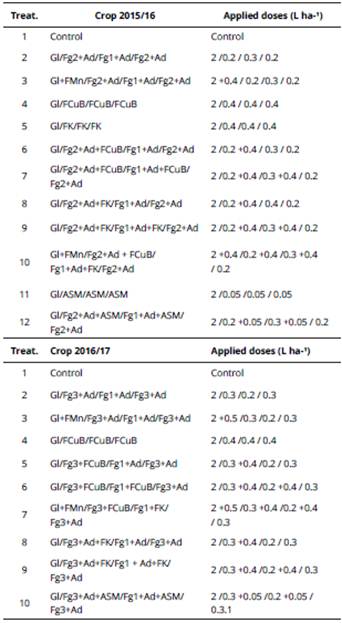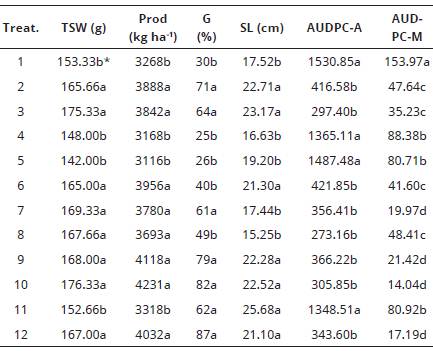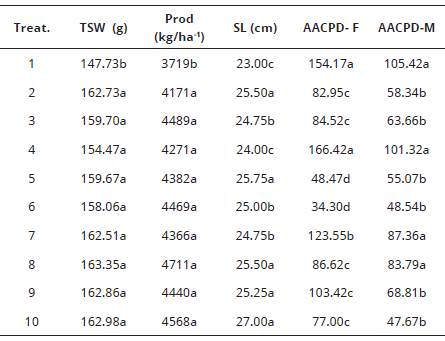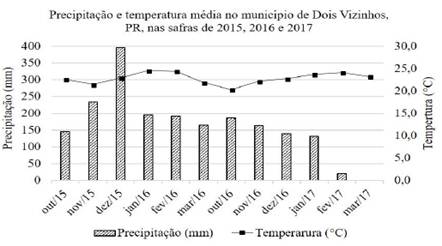Introduction
Glycine max (L.) Merrill has unquestionable importance in the global agricultural sector and Brazil is one of the largest producers and grain exporters. In Brazil, soybean is in a position to expand its production in order to supply much of the world demand. However, the quality of grain and productivity need to be high, in order to increase the competitiveness of Brazilian producers across the international market. This increase, in turn, is associated with scientific advances and the availability of technologies to the productive sector (Freitas, 2011).
Some aspects hinder the increase in soybean yield, highlighting the occurrence of pests and diseases. The diseases caused by fungus are of the greatest importance, both for damage to grain yield and the quality of the seed produced. Moreover, many of these organisms have in the seed which its primary vehicle for spreading and introduction into new areas of cultivation may cause damage to the crop in favorable environmental conditions (Henning, 2004).
The induction of pathogens resistance in plants is characterized by the activation of their defense mechanisms inherent in expression to morphological, physiological and biochemical responses that limit pathogen activity in their tissues. Inducing substances, of biotic and abiotic origin, have been distinguished by their efficiency in different cultures, as alternatives of use a consortium, substitution to the pulverization of traditional xenobiotics and conventional seed treatment (Rodrigues et al., 2012).
A variety of substances have been used for this purpose. Among them, the phosphites stand out, which, like inductors, stimulate the formation of substances, protecting the plant against the attack of fungi by its self-defense. Its activity on the control of plant diseases can occur directly, inhibiting the development of the pathogen, or indirectly, when they induce the production of substances such as enzymes and phytoalexins and these will act on the pathogen, inducing plant resistance. As the fungicide effect can act directly on the fungus and applied either alone or in combination with fungicides, with additive or synergistic result which assists in reducing the intensity of diseases (Carmona and Sautua, 2011; Silva et al., 2013).
There are several studies confirming this property in ASM in many agronomic plants (Santos et al., 2011; Silva et al., 2013). The aim of the study was to evaluate the chemical management of ‘eyespot’ and the induction of resistance by the use of phosphites and acibenzolar-S-methyl (ASM), in association with commercial fungicides affect the quality of soybean seeds.
Material and methods
The experiments were conducted in the municipality of Dois Vizinhos, state of Paraná (Brasil), divided into two field trials during the 2015/16 and 2016/17 seasons. Both trials were seeded with C2 seeds of cultivar NIDERA NA 5909 RG produced in the previous harvest. The tests were implemented in a no-tillage system on the straw. The basic fertilization followed the recommendations of soil analysis for the culture and applied 350 kg.ha-1 NPK fertilizers 02-24-18.
The experimental design was randomized blocks. In the 2015/16 crop, 12 treatments, resulting from commercial product mixtures with the inductors studied in three replicates, were tested, totaling 36 experimental units (EU). In the 2016/17 crop, we chose to test 10 treatments, with four replicates, totaling 40 EU. For both tests, the EU consisted of five lines, 2.25 m wide and 5 m long, spaced at 0.45 m, completing a total area of11.25 m2. The observation units (UO) went to the three central lines of the EU, discarding each end 0.5 m, totaling 5.4 m2. The spraying corresponded to combinations of glyphosate herbicide, commercial fungicides, phosphite based products, and plant activator ASM, and a control without any treatment for disease control, with only applying the herbicide described for weed control. Table 1 shows the combinations and sequences of the products applied.
Table 1 The sequence of the application of the products used in the crop of 2015/16 and 2016/17.

* Glyphosate. Fg fungicide. Ad: Adjuvant. ASM: Acibenzolar-S-methyl.
In both crops, the concentrations of active products and applied doses were: Glyphosate 480 gl/l (2 L ha-¹); acibenzolar-s-metil (ASM) 500g/kg (0.05 L ha-¹); the manganese phosphite - FMn 9% Mn, 2.5% Mo, 24% phosphite (0.5 L ha-¹); of Potassium - FK 40% P2O5, 10% K2O, 25% phosphite (0.4 L ha-¹); and Copper and Boron - FCuB 4% Cu, 2% B, 24% phosphite (0.4 L ha-¹). Only the fungicides and the applied doses varied according to the crop. In the 2015/16 crop, the fungicides Fg1: Azoxystrobin + Benzovinindiflopi 300 g/l+150g/l (0.3 L ha-¹); and Fg2: Azoxystrobin + Ciproconazole 200 g/l + 80 g/l (0.2 L ha-1). During the 2016/17, the fungicides used were Fg1: Azoxystrobin + Benzovindiflupir (0.2 L ha-1) and Fg3: Picoxystrobin + Ciproconazole (0.3 L ha-1).
The efficiency of applications on the control of pathogens was measured by the severity of the disease and this was used to calculate the area under the disease progress curve (AACPD), observing four marked plants, chosen at random in each EU. These were labeled randomly and evaluated nine leaflets, three in each third (bottom, middle and top) of the plant. To estimate severity, diagrammatic scales were used for mildew (Peronospora manshurica) (Kowata et al., 2008) and asian soybean rust (Phakopsora pachyrhizi) (Godoy et al., 2006). Five severity evaluations were performed for asian soybean rust and three for mildew, an interval of 7 and 14 days, respectively, from the V4 stage. The average values of severity of each plot were used to calculate the AACPD (Campbell and Madden, 1990).
In both trials, the crop performed manually, occurred in the R7.3 stage (more than 76% of leaves and yellow pod) (Ritchie et al., 1982), wherein seeds with mean levels ranging water between 14.5 and 17%. For the trail, a motorized plotter with track and cleaning function was used. The harvested seeds were advantaged in an air screen cleaner for cleaning and standardization.
These samples were placed in cotton packaging and put to dry in a stationary dryer sample with forced air at 35 °C, in order to homogenize the water content until the seeds reached the equilibrium moisture content at 13%. It determined the moisture content of the seeds by the oven method at 105±3 °C, according to the methodology prescribed by the Rules for Seed Analysis - RAS (Brasil, 2009). Further, by weighing the sample on a precision scale, it calculated the seed productivity - Prod (kg. ha-1). The samples were homogenized and still quartered to obtain working samples according to RAS (Brasil, 2009), which evaluated the quality attributes of the seeds. Were measured: weight of one thousand seeds - WTS (g); germination - G (%) and length of seedlings - LS (cm) (Brasil, 2009; Marcos-Filho, 2015).
The data set was subjected to Lilliefors test of normality and homogeneity of variance of Bartlet, and the data of AUDPC-M and AUDPC-F variables processed by chi-square (X2 + K), the means presented are unique and discriminatory letters referring to adjusted averages. Met the assumptions of the statistical model, the level of significance of the treatments was tested by F test at 5% probability of error. Where significant treatments, were analyzed by means of Scott- Knott test, 5% level of probability. Statistical analyses were performed using the Assistat® statistical software.
Results and discussion
The response variables influenced differently for each crop depending on the treatments. In the experiment 1, conducted in the harvest of 2015/16, treatments were significant on the variables PMS, PROD, G, CP and AACPD for asian soybean rust and mildew (Table 2).
Table 2 Thousand seed weight (TSW), productivity (Prod), germination (G), seedling length (SL), area under the disease progress curve of asian soybean rust (AUDPC-A) and mildew (AUDPC-M), in an experiment conducted in the 2015/16 crop.

*Data not followed by the same letter in a column are statistically different from each other by Scott-Knott, at 5% level of probability. Trat = treatment.
The treatments Copper and Boron (FCuB) (T4), FK (T5), acibenzolar-s-metil (ASM) (T1l) and control (T1) had lower mean WTS and Prod, differing from the others (Table 2). In all these treatments did not apply fungicides. It can be inferred that they do not efficiently controlled pathogens as the other treatments, or, as suggested Peruch and Bruna (2008)), had occurred phytotoxic effect on metabolic processes in soybean plants, negatively interfering in the evaluated parameters.
The Table 2 shows that the treatments comprise fungicides or not associated phosphites were more productive, probably due to the control of diseases by culture fungicides. Even triazole fungicides commonly used in agriculture can cause a bio-stimulant effect on plants.
For the germination (G) (Table 2) the T2, T3, T7, T9, T10, T11, and t12 treatments presented the highest averages (61 - 82%). However, taking into account that the minimum germination standard for soybean seed marketing is 80%, it is possible to distinguish only T10 and T12 with satisfactory physiological quality. During the development of culture, before and after physiological maturity in the season 2015/16, there were successive rains that delayed the harvest. It could be observed in Figure 1 that during the month of February, when the harvest was carried out, the average precipitation was 191.2 mm distributed in 24 days. Probably there have been successive hydrations and dehydration and consequently, the deterioration of the seeds still in the field, compromising their quality.
The excess moisture in the period following the physiological maturity and mature field compromised the physiological seed quality (Silva et al., 2013; Marcos Filho, 2015). On the length of seedlings (LS) (Table 2), treatments T2, T3, T6, T9, T10, T11, and T12 differed from the others. It is noted, however, that the lowest averages occurred in the treatments containing Potassium (FK) and Copper and Boron (FCuB) and when the applications were repeated three times. Possibly it may have been cause toxic effects in the mother plant, coming to affect the length of seedlings produced in the seeds. Thus, from the point of view of the quality of the seeds in the first year of conducting the test, the use of phosphites and in isolation ASM was not efficient on the variables analyzed. Also, the use of fungicides with or without the phosphite and the ASM promoted satisfactory results.
About AACPD-F, treatments corresponding to the use of Copper and Boron (FCuB) (T4) and Potassium (FK) (T5) and ASM (T11) alone did not differ from control (T1) did not reduce disease severity in the culture. However, other associations between treatments corresponding phosphites, fungicides and plant activator ASM differed (Table 2). A similar result obtained by Neves and Blum (2014)) on the severity of asian soybean rust in crop shows that the use of phosphites isolated or associated with fungicides is efficient, but they do not differ significantly from one another. Other studies have demonstrated a significant increase in severity reduction when using phosphites and ASMs associated with the fungicide cyproconazole + azoxystrobin (Silva et al., 2013).
Regarding AACPD -M, all treatments differed from the control, and T7, T9, T10, and T12 showed a greater reduction of disease severity. In T7 and T9, the Cu and K phosphites were applied twice, which was more efficient than applying the once only (T6 and T8). The association of FK with fungicides (T9) promoted 21.42 AACPD-M, compared to using FK alone (T5) with 80.71 and only with the application of fungicides (T2) with 47. Thus, T9 reduced about 75% of AACPD-M in relation to T5 and 45% in relation to T2. For Silva et al. (2011)), the application of FK in soybean is efficient both in reducing the severity of mildew and in asian soybean rust.
In T10 was tested implementation of the three phosphites (Cu, K, and Mn). In this case, there was probably a synergistic effect between phosphites and fungicides, which potentiate the action of the molecules of fungicides, resulting in toxic effects on the pathogen. The acidity of the phosphite directly interferes with the development of the fungi, decreasing their growth (Araujo et al., 2010) and significantly reducing the mildew severity (Silva et al., 2011).
The fungicide application associated with ASM (T12) showed more efficient results when compared to the same application isolation. Silva et al. (2013)) found that ASM when associated with the pyraclostrobin + epoxiconazole fungicide also reduced the severity of mildew in soybean cultivation and, when applied in isolation, had no effects on disease control.
In experiment 2, season 2016/2017, treatments were significant variables on the weight of one thousand seeds (WTS), Prod and length of seedlings (SL), AUDPC asian soybean rust and mildew (Table 3).
Table 3 Thousand seed weight (TSW), productivity (Prod), seedling length (SL), area under the disease progress curve of asian rust (AUDPC-A) and mildew (AUDPC-M), in an experiment conducted in 2016/17 crop.

*Data not followed by the same letter in column are statistically different from each other by Scott-Knott at 5% level of probability. Trat = Treatment
Regarding the variables WTS and Prod, all the treatments differed from the control, being superior to this one. Effective in controlling the severity of rust and mildew, the treatments employed provided a loss in grain filling and number of pods per plant smaller than in the control, which showed yellowing and defoliation (Neves and Blum 2014). This favored the greatest mass of a thousand grains and productivity. Another factor to be taken into account is that foliar nutrient application results in increased productivity and seed formation with higher physiological quality (Fageria et al., 2009). Therefore, this must occur when the nutritional requirements are higher at the start of grain filling, characterized in that the transition at the end of stage R4 and R5 (Taiz and Zeiger, 2013). This was the time in which the latest treatments application, ensuring greater grain quality and productivity compared to the control (Table 3).
For the variable SL (Table 3) the highest averages were obtained with the application of T2, T5, T8, T9, and T10 treatments. The control of diseases in the soybean crop had been carried out with two to three applications of fungicides, starting from the flowering and yet, damages caused by diseases, are verified annually (Yorinori et al., 2005). This practice has a high cost and, as can be seen in the results obtained for the SL, this cost can be reduced by using alternative sources, such as resistance inducers combined with fungicides, without compromising the plant’s development.
About AACPD asian soybean rust (Table 3) increased efficiency was observed with the use of FCuB (T5 and T6) associated with fungicides, which differed significantly from other treatments. Analogous results obtained by Neves and Blum (2014)) and Silva et al. (2011)) about the severity of asian rust on soybean show that the use of phosphites associated with fungicides is efficient, being superior to the control treatment. The control of asian soybean rust is also efficient with the use of fungicide only, or of that associated with ASM (Carvalho et al., 2013).
For asian soybean rust, treatments based on FCuB associated with fungicides presented better results in the control of the disease, possibly having a synergistic effect between them. The acid phosphite interferes directly on the development of fungi and combined use with fungicides, enhancing the action of the molecules, causing direct toxic effects on the pathogen and decreasing their growth (Araujo et al., 2010). It may also be related to the possible activation of the defense mechanisms of the plant against the pathogen, since the phosphites present the potential to intensify the synthesis of ascorbic acid, phytoalexins, phenolic compounds and lignin, which indirectly interfere with the incidence and development of pathogens in plants (Moor et al., 2009).
The use of the different sources of phosphites (Mn, K and Cu) and ASM on the AACPD of mildew (Table 3) showed significant results on the control of mildew in relation to the (T1), which proves with the other results obtained in the control of the same pathogen in the soybean crop (Silva et al., 2011; Silva et al., 2013). However, the same effect of the isolated use of the different phosphite and ASM sources was also observed using the combination of different fungicides (T2 - fungicidal standard).
In general, greater development of mildew and asian soybean rust occurred in the plants where FCuB was applied without association with fungicides (T4) and the combination of three phosphites (Mn, K, and Cu) combined with fungicides (T7). Thus, it is possible to infer that there were cause toxic effects or incompatibility when phosphite was applied jointly. However, when using only one type of phosphite associated with fungicides, the effect was satisfactory but using only the like fungicides. These results can be viewed mainly in the final crop cycles, depending on the physiological responses of plant defense after treatment application.
Conclusions
The use of phosphite and ASM, with and without the combination of fungicides Azoxystrobin + Benzovinindiflopi, Azoxystrobin + Ciproconazole e Picoxystrobin + Ciproconazole, did not reduce the severity of the mildew and asian soybean rust; Three applications of the same phosphorized phytotoxic effect on soybean crop, compromising yield and seed quality; The use of combinations of different fungicides was sufficient to mitigate the severity effects of the mildew and asian rust on soybean crop.















